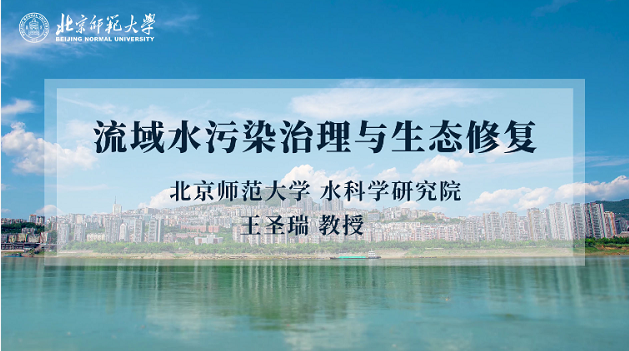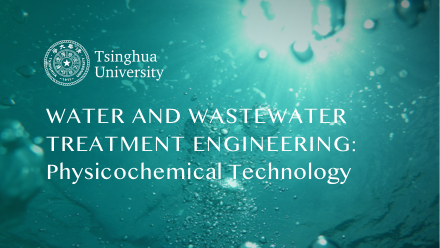
当前课程知识点:Water and Wastewater Treatment Engineering: Physicochemical Technology > Chapter 6 Ion-exchange > 6-7 Ion-exchange equipment > 6-7 Ion-exchange equipment
返回《Water and Wastewater Treatment Engineering: Physicochemical Technology》慕课在线视频课程列表
返回《Water and Wastewater Treatment Engineering: Physicochemical Technology》慕课在线视频列表
同学们好!在这一讲,我们给同学们介绍离子交换设备
离子交换设备是离子交换工艺中的重要组成
包括离子交换器、再生液系统、除二氧化碳器等
离子交换器是发生离子交换反应的场所,是离子交换工艺的核心设备
按照运行方式不同,离子交换器分为固定床、连续床以及混合床
其中固定床是离子交换器的最基本运行方式
应用最为广泛,以下我们重点加以介绍
固定床按照水、再生液的流动方向以及运行方式
又分为顺流再生固定床、逆流再生固定床、分流再生固定床、满室床和浮动床等
其中顺流再生和逆流再生是应用最广泛的两种方式,下面分别介绍
首先介绍顺流式固定床离子交换器
顺流式固定床是指运行时水的流动和再生时再生液的流动方向均为由上向下
故称为顺流
这是顺流式固定床装置结构的示意图
主要组成包括进水管、进水装置、进再生液装置、树脂层
石英砂垫层、出水管、反洗排水管、正洗和再生排水管、反洗进水管
进再生液管、排空气管等
顺流式固定床的工作过程包括
运行→反洗→再生→正洗
运行时,原水经进水管和进水装置,分配到离子交换树脂层上部
经树脂层、石英砂垫层后,经底部的出水管收集并排出
当树脂达到饱和后,就需要再生
首先进行水的反冲洗,即从底部进反冲洗水
经石英砂垫层、树脂层,再经上部的反洗排水管排出
然后再进行树脂的再生
在顺流再生中,再生液从树脂层的上部进入
经过树脂层、石英砂垫层,从底部再生排水管排出
然后再用干净的软化水进行正洗
清水经过进水管、进水装置,经树脂层、石英砂垫层后,从底部排出
清洗结束后,离子交换器就可以再次投入运行
接下来,介绍逆流式,也可称为对流式固定床离子交换器
在逆流式固定床中,运行时被处理的水自上向下流动
而再生时再生液自下向上流动
逆流式固定床的再生方式与顺流式固定床相比,略微复杂
这个图显示了逆流式固定床气顶压法再生过程
首先进行小反洗,即从中间排水装置引入反洗水
把累积在树脂层上部的杂质冲洗下来并排出
然后将中间排水层的水放掉
从离子交换器顶部进压缩空气
再从底部进再生液,逆流经过树脂层,对树脂进行再生
再生液从中间排水装置排出
然后再从底部进软化的清水对树脂层中残存的再生液进行置换
最后从顶部进软化的清水,对树脂层进行正洗
再生结束后,离子交换器可以再投入运行
顺流再生时,由于原水与再生液均为由上向下同一方向流动
因此,树脂层上部再生度高,而下部再生度低
再生度较低的树脂处于离子交换器的出水端,影响出水水质
由于树脂整体再生度较低,导致树脂工作交换容量偏低
因此,顺流再生式固定床适用于原水离子浓度,比如硬度较低的场合
而逆流再生时,再生液流向与运行时水流流向相反
因此,再生比较充分,再生剂用量可以降低20%以上
同时,树脂的工作交换容量较高
由于再生比较彻底,因此出水水质较好
因此,逆流再生式固定床适用于原水离子浓度,比如硬度较高的场合
在再生过程中,对于Na型阳离子交换树脂,可以用食盐进行再生
对于H型阳离子交换树脂,可以用HCl或H2SO4再生
对于碱性阴树脂,可以用NaOH再生
也可以用NaHCO3和Na2CO3对弱碱性阴树脂进行再生
下面,以逆流再生为例,介绍固定床离子交换器中树脂层的饱和程度
当离子交换器开始泄漏时,树脂层的饱和程度可以用这个图来表示
其中区域(1)表示再生、清洗后
整个树脂层的交换能力未能得到再生所占的部分
(2)代表运行工作期间,树脂层交换能力实际用于离子交换所占的部分
(3)代表当交换器开始泄露硬度时,树脂层中交换尚未利用所占的部分
根据三部分的比例,可以计算出树脂的实际利用率等于下面这个表达式
而树脂层的再生度等于这个表达式
树脂层饱和度等于下面这个式子
根据树脂层实际利用率,可以计算出树脂的工作交换容量q=ηq0
其中q0是指树脂全交换容量,实际利用率η与树脂层的再生度和饱和度有关
一般在60-80%左右,与具体的离子交换器运行条件有关
-0-2 Water treatment process
-0-3 Wastewater treatment process
--0-3 Wastewater treatment process
-Chap 0 Homeworks
-1-1 Introduction
-1-2 Properties of colloids
-1-3 Mechanisms and process of coagulation and flocculation
--1-3 Mechanisms of coagulation and flocculation
-1-4 Coagulant and coagulant aids
-- 1-4 Coagulant and coagulant aids
-1-5 Kinetics of coagulation and flocculation
--1-5 Kinetics of coagulation and flocculation
-1-6 Factors affecting the coagulation performance
--1-6 Factors affecting the coagulation performance
-1-7 Facilities for coagulation and flocculation
--1-7 Facilities for coagulation and flocculation
-Chapter 1 Homeworks
-2-1 Introduction
-2-2 Discrete particle settling
--2-2 Discrete particle settling
-2-3 Flocculent settling
-2-4 Zone settling
-2-5 Rectangular settling tank
--2-5 Rectangular settling tanks
-2-6 Process calculation of rectangular settling tanks
--2-6 Process calculation of rectangular settling tanks
-2-7 Vertical Flow (up-flow ) and radial flow settling tank
--2-7 Vertical Flow (up-flow ) and radial flow settling tank
-2-8 Plated sedimentation tank
--2-8 Plated sedimentation tank
-2-9 Clarification pool
-3D interactive demonstration for settling tanks
-Chapter 2 Homework (part 1)
-Chapter 2 Homework (part 2)
-3-1 Introduction
-3-2 Theoretical foundation of air floatation
--3-2 Theoretical foundation of air floatation
-3-3 Pressurized dissolved air flotation
--3-3 Pressurized dissolved air flotation
-Chapter 3 Homework
-4-1 Introduction
-4-2 Structure and process of conventional rapid filter
--4-2 Structure and process of conventional rapid filter
-4-3 Water head loss of filter
--4-3 Water head loss of filter
-4-4 Filtration method of filter
--4-4 Filtration method of filter
-4-5 Filter media
-4-6 Water distribution system
--4-6 Water distribution system
-4-7 Filter backwashing
-4-8 Siphon filter
-4-9 Gravity valveless filter
--4-9 Gravity valveless filter
-4-10 Movable hood filter
-3D interactive demonstration for filtration tanks
--Usage and description for 3-D demonstration
-Chapter 4 Homework
-5-1 Introduction
-5-2 Influence factors of disinfection
--5-2 Influence factors of disinfection
-5-3 Chlorine disinfection
-5-4 Chlorine dioxide disinfection
--5-4 Chlorine dioxide disinfection
-5-5 Ultraviolet disinfection
--5-5 Ultraviolet disinfection
-Chapter 5 Homework
-6-1 Ion-exchange resin
-6-2 Properties of ion-exchange reactions
--6-2 Properties of ion-exchange reactions
-6-3 Properties of cation exchange resin
--6-3 Properties of cation exchange resin
-6-4 Properties of anion exchange resin
--6-4 Properties of anion exchange resin
-6-5 Softening system using ion exchange
--6-5 Softening system using ion exchange
-6-6 Desalination system using ion exchange
--6-6 Desalination system using ion exchange
-6-7 Ion-exchange equipment
-6-8 Treatment of industrial wastewater by ion-exchange method
--6-8 Treatment of industrial wastewater by ion-exchange method
-Chapter 6 Homework
-7-1 Introduction
-7-2 Principle and characteristics of electrodialysis
--7-2 Principle and characteristics of electrodialysis
-7-3 Configuration of electrodialysis unit
--7-3 Configuration of electrodialysis unit
-7-4 Operating parameters for electrodialysis unit
--7-4 Operating parameters for electrodialysis unit
-7-5 Principle and process of reverse osmosis
--7-5 Principle and process of reverse osmosis
-7-6 Operating parameters for reverse osmosis
--7-6 Operating parameters for reverse osmosis
-7-7 Principles and characteristics of UF and MF
--7-7 Principles and characteristics of UF and MF
-7-8 Design of ultrafiltration and microfiltration process
--7-8 Design of ultrafiltration and microfiltration process
-Chapter 7 Homework
-8-1 Fundamental knowledge and classification
--8-1 Fundamental knowledge and classification
-8-2 Ozonation
-8-3 Photo-catalytic oxidation
--8-3 Photo-catalytic oxidation
-8-4 Supercritical water oxidation
--8-4 Supercritical water oxidation
-8-5 Electrolysis
-Chapter 8 Homework
-9-1 Introduction
-9-2 Adsorption equilibrium and adsorption isotherm
--9-2 Adsorption equilibrium and adsorption isotherm
-9-3 Adsorption breakthrough curve
--9-3 Adsorption breakthrough curve
-Chapter 9 Homework



